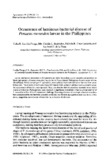Search
Now showing items 1-10 of 38
Mortality of pond-cultured Litopenaeus vannamei associated with acute hepatopancreatic necrosis disease (AHPND) and white spot syndrome virus (WSSV) infection in the Philippines
(Japanese Society of Fish Pathology, 2017)
Mortalities of up to 60% were observed in pond-cultured Litopenaeus vannamei in Bohol, Philippines. Histopathological examination revealed typical acute hepatopancreatic necrosis disease (AHPND) pathology. PCR test generated ...
Surveillance of emerging fish viral pathogens in some Southeast Asian countries
(Society of Israeli Aquaculture and Marine Biotechnology, 2009)
Preventing the transboundary movement of fish viral pathogens in a global environment requires active surveillance. This study examined the presence of three emerging viral pathogens among koi, common, grass, and silver ...
Abdominal segment deformity syndrome (asds) and fused body segment deformity (fbsd) in cultured Penaeus indicus
(Elsevier, 2017)
The abdominal segment deformity disease (ASDD) is a new shrimp disease reported only in cultured Penaeus vannamei in Thailand. Shrimp with ASDD have deformed abdominal segment, jagged gut line and bumpy surfaces. Similar ...
Acute hepatopancreatic necrosis disease (AHPND) outbreaks in Penaeus vannamei and P. monodon cultured in the Philippines
(Inter Research, 2015)
Acute hepatopancreatic necrosis disease (AHPND) has recently emerged as a serious disease of cultured shrimp. It has also been described as early mortality syndrome (EMS) due to mass mortalities occurring within 20 to 30 ...
Studies on the chemical control of luminous bacteria Vibrio harveyi and V. splendidus isolated from diseased Penaeus monodon larvae and rearing water
(Inter Research, 1990)
The minimum inhibitory concentrations (MICs) and minimum bactericidal concentrations (MBCs) of 24 drugs for luminous bacteria Vibrio harveyi and V. splendidus were determined. Only chloramphenicol, sodium nifurstyrenate ...
Prevalence of white spot syndrome virus (WSSV) in wild shrimp Penaeus monodon in the Philippines
(Inter Research, 2007)
Prevalence of white spot syndrome virus (WSSV) was determined using polymerase chain reaction (PCR) methodology on DNA extracted from the gills of wild black tiger shrimp Penaeus monodon collected from 7 sampling sites in ...
Occurrence of luminous bacterial disease of Penaeus monodon larvae in the Philippines
(Elsevier, 1990)
Larval mortalities associated with luminescence have been observed in epizootic proportions in black tiger prawn (Penaeus monodon) hatcheries in Panay Island, Philippines. Luminescent vibrios, identified as Vibrio harveyi ...
Occurrence and pathology of Penaeus monodon baculovirus infection in hatcheries and ponds in the Philippines
(Society of Israeli Aquaculture and Marine Biotechnology, 1991)
Samples from Penaeus monodon hatcheries (2-3 day old larvae or Zoea 1 to 34 day old post larvae or PL<sub>34</sub>) and ponds (15 to 159 days old in the pond) were histologically examined for the presence of eosinophilic ...
Prevalence of viral nervous necrosis (VNN) virus in wild-caught and trash fish in the Philippines
(European Association of Fish Pathologists, 2011)
Viral nervous necrosis (VNN) caused by piscine nodavirus is a devastating disease affecting mainly marine finfish. In the Philippines, VNN was first reported in hatchery-reared grouper (Epinephelus coioides) broodstock in ...
Antibiotic resistance of bacteria from shrimp ponds
(Elsevier, 2001)
The incidence of antibiotic resistance was compared in bacteria isolated from pond water, pond sediment, water and sediment from the receiving environment (area where water from pond drains, which is 0 and 50 m away from ...











